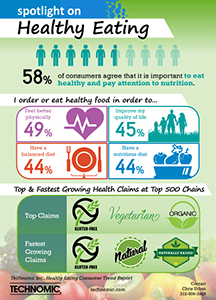Hey, Arugula. What’s Your Story?
15 January 2015
 Consumers increasingly want to know what’s in their food, says Technomic. Can restaurants produce dishes that are both wholesome and delicious? A majority of diners apparently thinks so.
Consumers increasingly want to know what’s in their food, says Technomic. Can restaurants produce dishes that are both wholesome and delicious? A majority of diners apparently thinks so.
Today’s healthy food tells a story, and consumers want to hear it. Recent research by Chicago-based Technomic shows that most consumers want restaurants to be more transparent about menu-item ingredients. Further, two in five consumers cite a rising concern over food additives.
Because of this growing concern, health claims that convey wholesome, pure ingredients resonate strongly. For example, consumers say fresh, natural or unprocessed attributes help improve perceived taste and health. Similarly, ingredients that naturally boost the nutrition content of an item, such as fruits and vegetables, also enhance taste and health perceptions.
“Menu transparency is imperative and can help drive sales of healthy options,” says Sara Monnette, senior director of Consumer Insights & Innovation at Technomic Inc. “Telling an ingredient’s story—whether it’s farm-raised, local or GMO-free, for instance—can directly impact consumer decisions about what to order and where to dine.”
Monnette also says access to this type of information at restaurants often makes consumers more likely to order what they perceive as a healthier item because it allows them to judge its nutritional benefit for themselves.
To help foodservice executives understand the latest consumer behaviors, preferences and attitudes regarding healthy eating, Technomic recently published an update of its Healthy Eating Consumer Trend Report. Interesting findings include:
- 62% of consumers believe restaurants can offer food that is both healthy and tasty.
- Consumers are more likely to eat healthy in order to maintain a balanced or nutritious diet than to control their weight.
- Consumers are most likely to buy healthy items at fast-casual and casual-dining concepts.
- Roughly one in four Millennials expects to purchase gluten-free packaged items more often now that gluten-free retail foods cannot have a detectable level of gluten.
